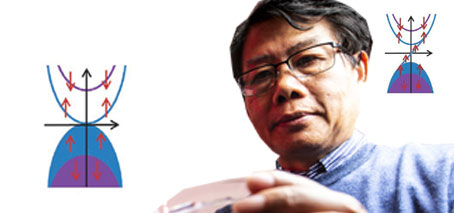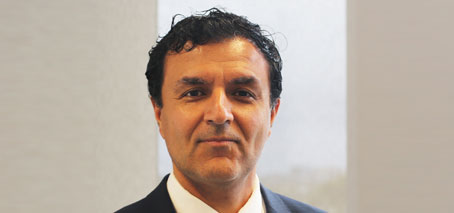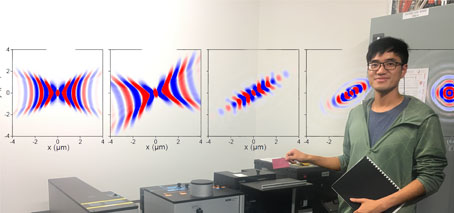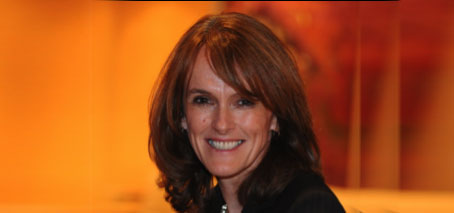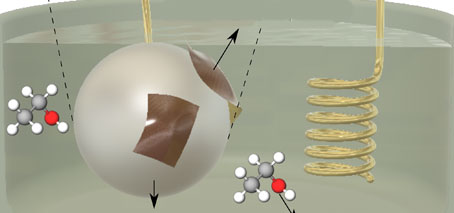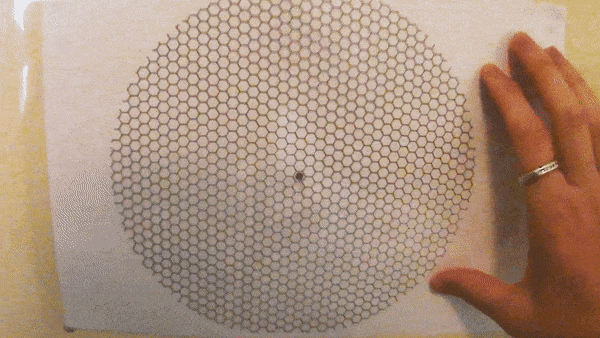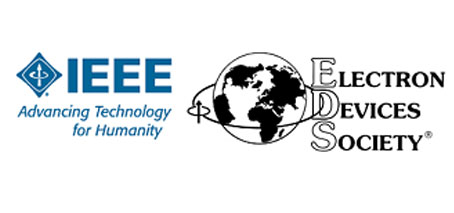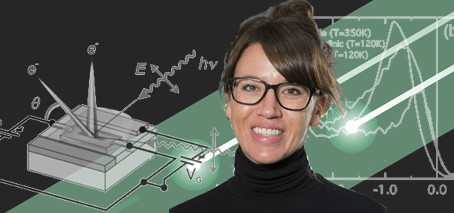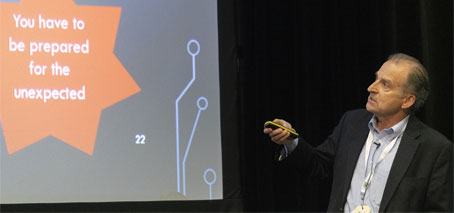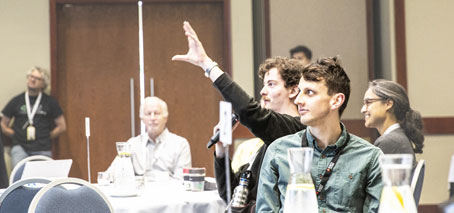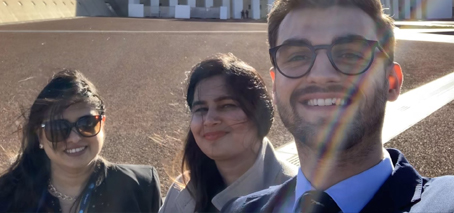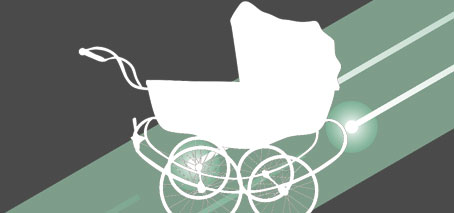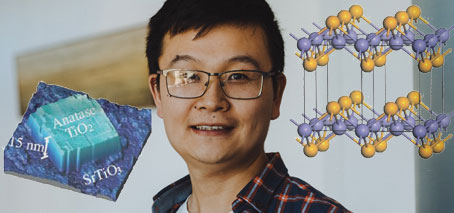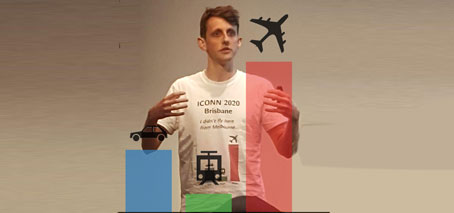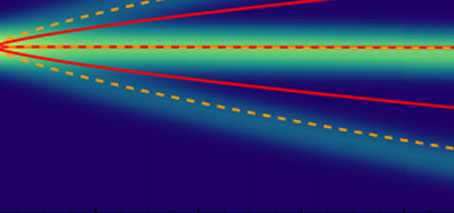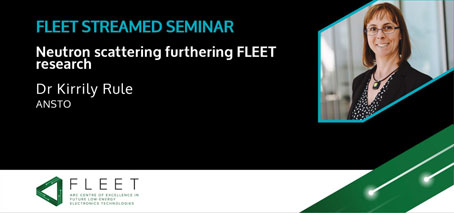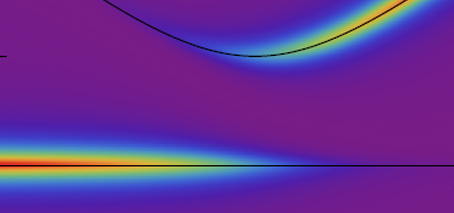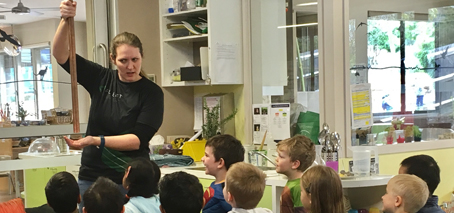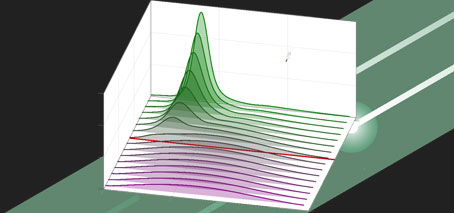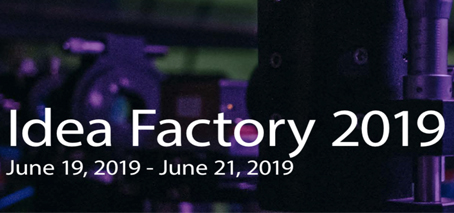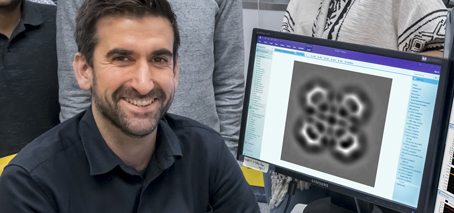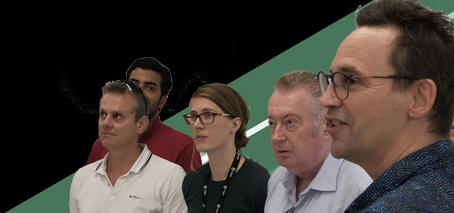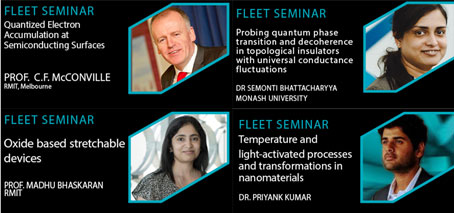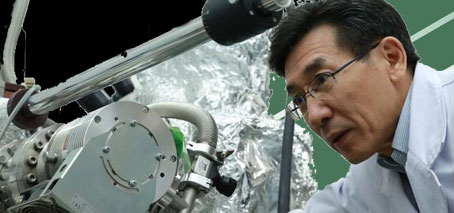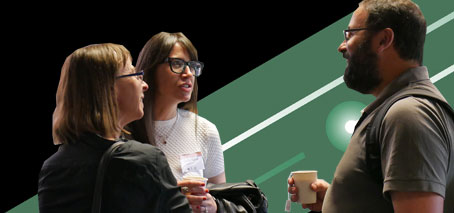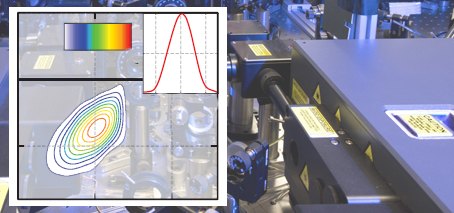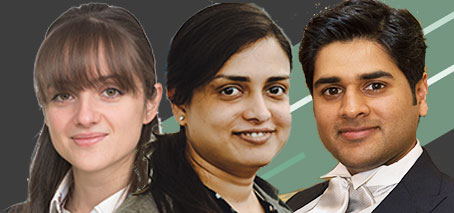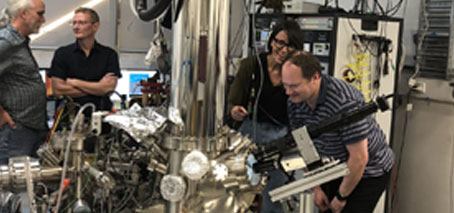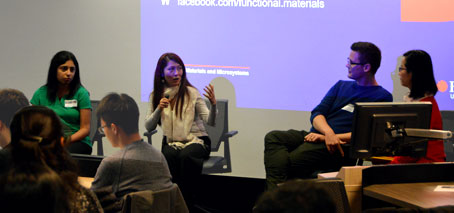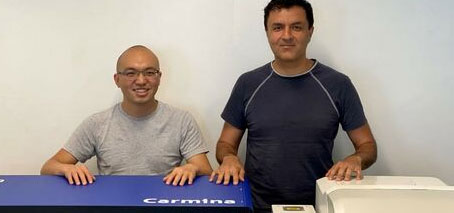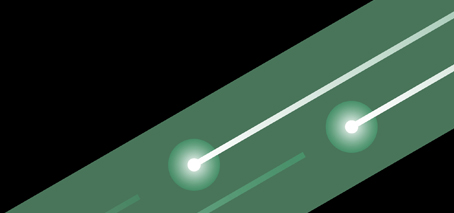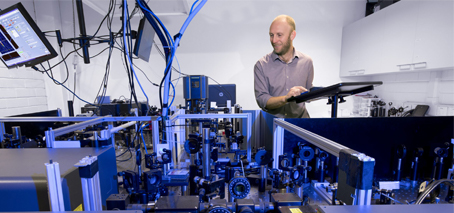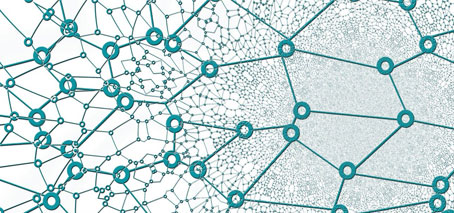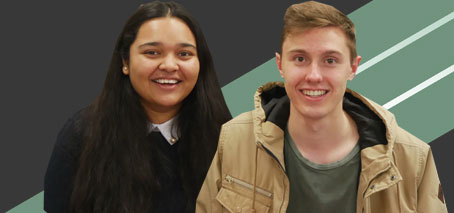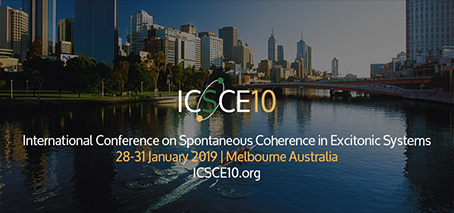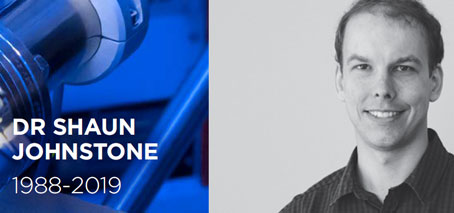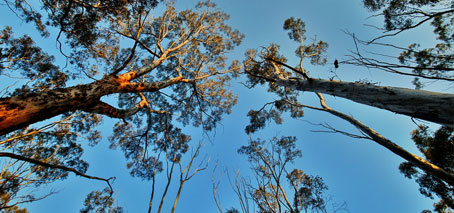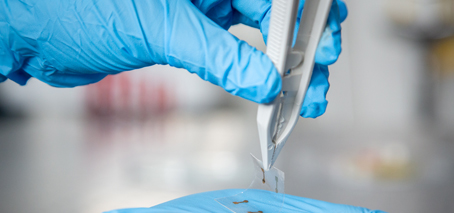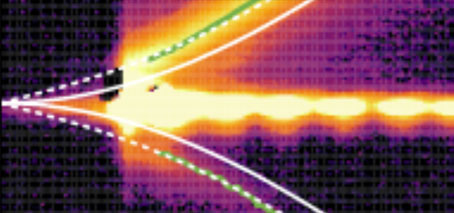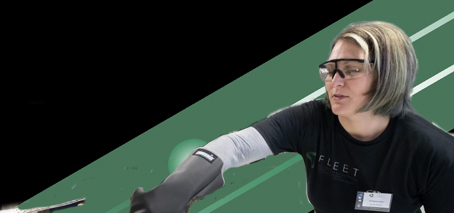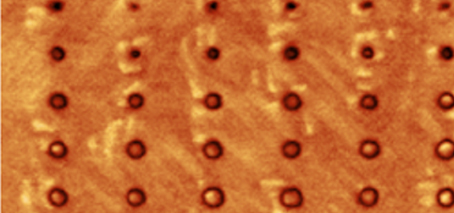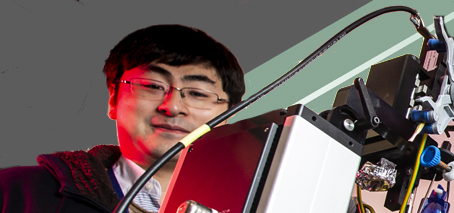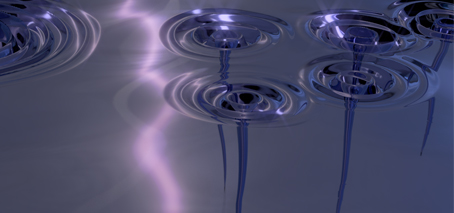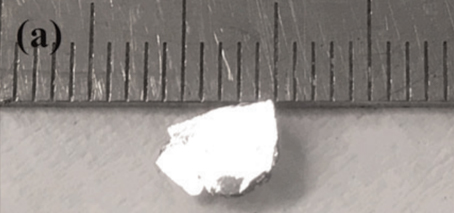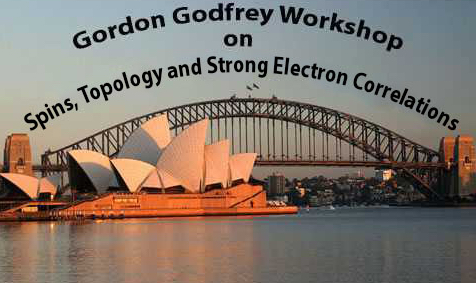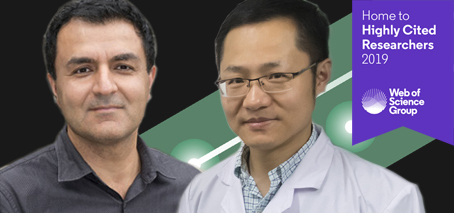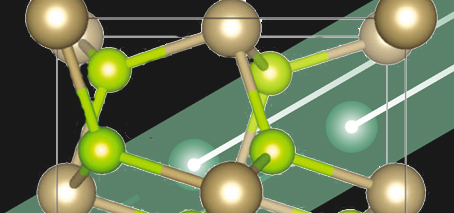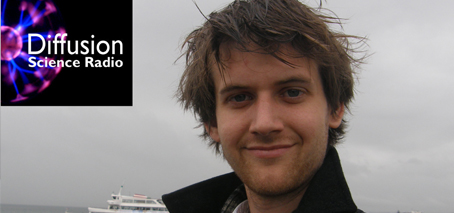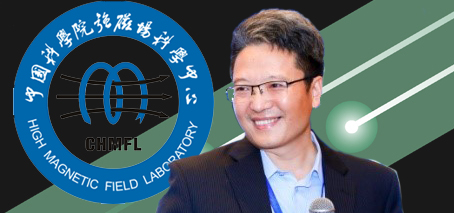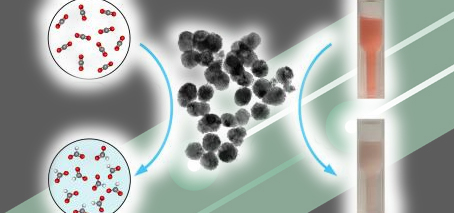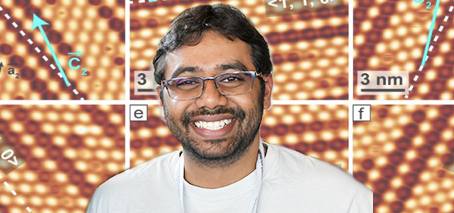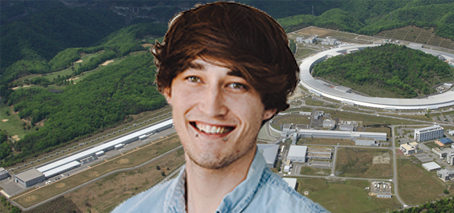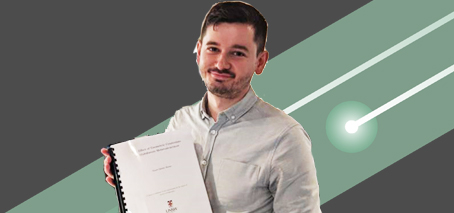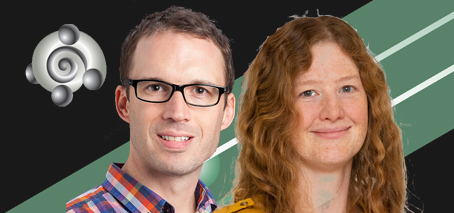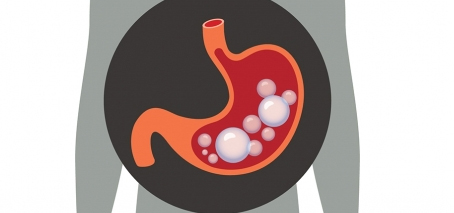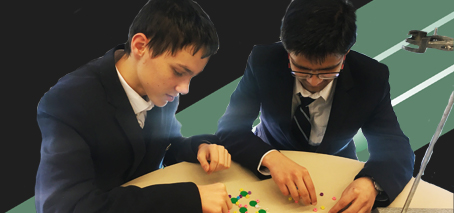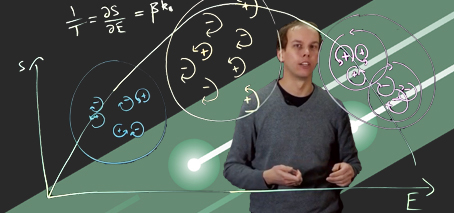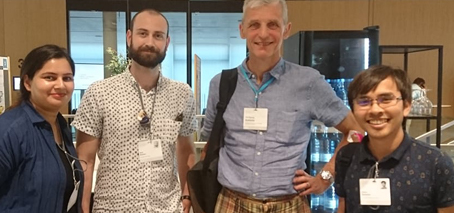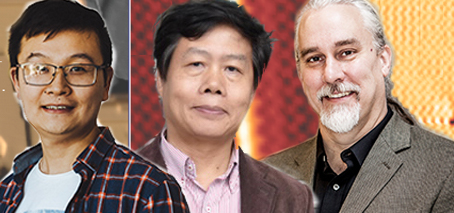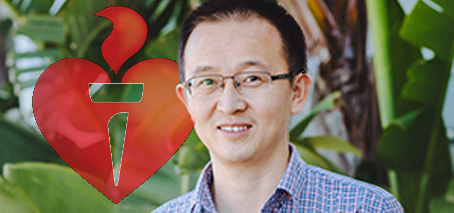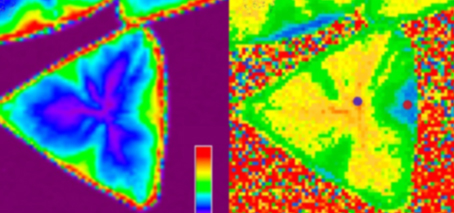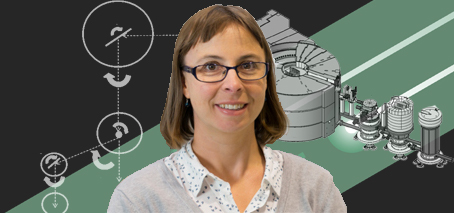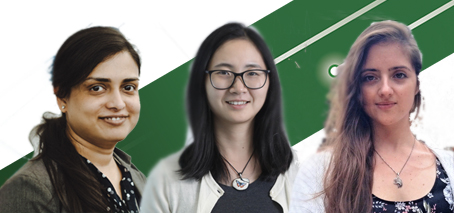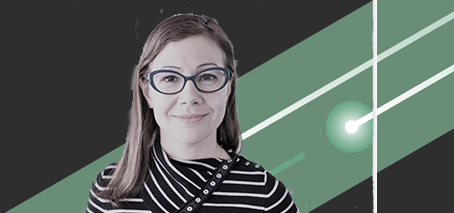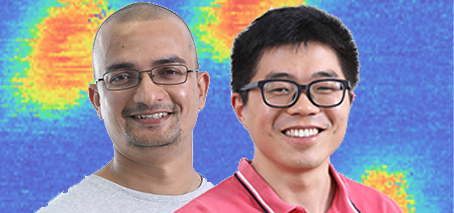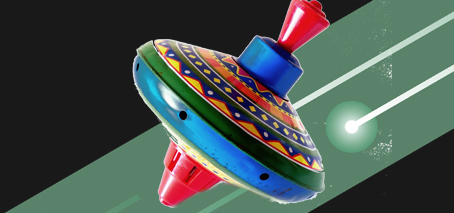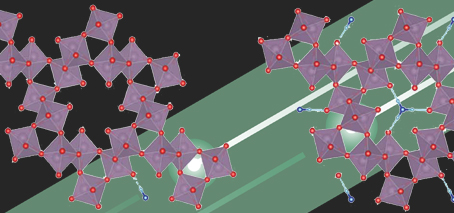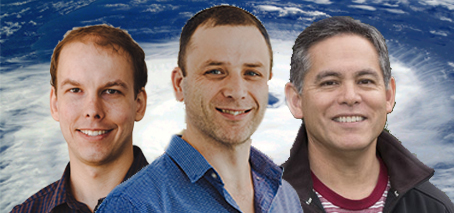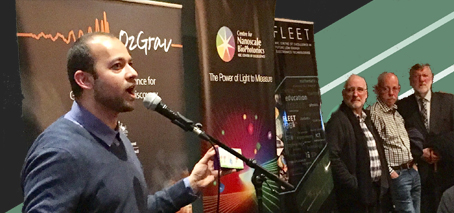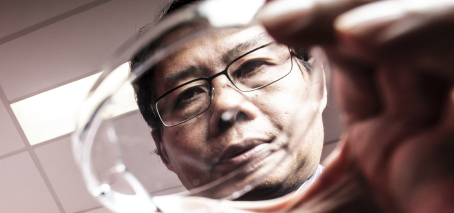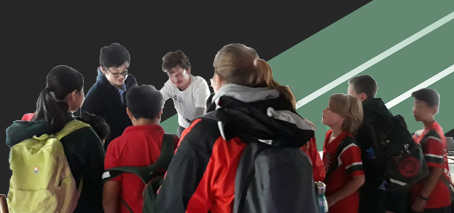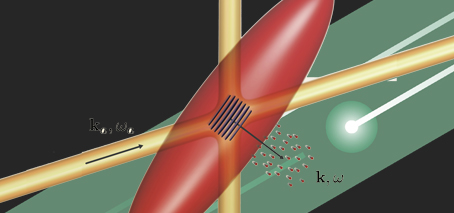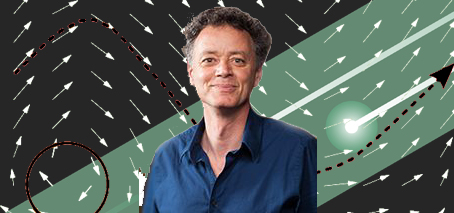Spin-gapless semiconductors (SGSs) are a new class of zero-gap materials, with fully spin polarized electrons and holes. SGSs bridge the zero-gap materials and half-metals Material’s fascinating spin and charge states hold great potential for future spintronic technology. A University of Wollongong team has published an extensive review of spin-gapless semiconductors (SGSs) . Spin gapless semiconductors (SGSs) are a new class …
FLEETs Kourosh Kalantar-zadeh awarded prestigious prize
FLEET CI Professor Kourosh Kalantar-zadeh (UNSW Sydney) has been awarded the prestigious 2020 Robert Boyle Prize for Analytical Science by The Royal Society of Chemistry. Prof Kalantar-zadeh is recognised for his significant influence across multiple fields of engineering. Contributions to society coming from his research across multiple disciplines include new innovative pollution sensors, transistors, medical devices and optical systems. Many …
Applying ‘magic angle’ twistronics to manipulate the flow of light
‘Twisted’ layers of 2D materials produce photonic topological transition at ‘magic’ rotation angles Principles of Moire-pattern bilayer graphene applied to 2D material photonics for first time Monash researchers are part of an international collaboration applying ‘twistronics’ concepts (the science of layering and twisting 2D materials to control their electrical properties) to manipulate the flow of light in extreme ways. The …
Cathy Foley recognised in Queen’s Birthday Honours
CSIRO Chief Scientist Dr Cathy Foley was recognised in this year’s Queen’s Birthday Honours for her distinguished service to research science, to the advancement of women in physics and to professional scientific organisations. Prior to becoming Chief Scientist, as Deputy and Science Director of CSIRO Manufacturing, Dr Foley worked to engage Australian manufacturers and researchers to translate research into economic …
Liquid metals break down organic fuels into ultra-thin graphitic sheets
For the first time, FLEET researchers at UNSW, Sydney show the synthesis of ultra-thin graphitic materials at room temperature using organic fuels (which can be as simple as basic alcohols such as ethanol). Graphitic materials, such as graphene, are ultra-thin sheets of carbon compounds that are sought after materials with great promises for battery storage, solar cells, touch panels and …
Explainer: Moire patterns in graphene and plastic
A recent FLEET homescience exercise explained how simple geometric patterns printed on transparency (‘overhead projector sheets’, to those of us old enough to remember such technology), and overlaid at varying angles, produced a combined ‘Moire’ pattern of varying dimensions. Two sheets of repeating squares produces a Moire pattern of larger squares. Two sheets of repeating triangles produces a Moire pattern …
What comes after CMOS? An expert discussion
A panel of experts featuring Dr Paolo Gargini (formerly Intel, head of several international semiconductor roadmaps), Prof Michelle Simmons (UNSW, Director. ARC Centre for Quantum Computation and Communication Technology) and Prof Michael Fuhrer (Monash Uni., Director of ARC Centre of Excellence in Future Low Energy Electronics Technologies.) and a guided discussion about the future of electronics beyond CMOS and the role semiconductors and other materials …
New CI Julie Karel
It is a great pleasure to announce that Dr Julie Karel (Monash) is now a FLEET Chief Investigator. Dr Karel conducts research at the intersection of materials science and condensed-matter physics, to develop new materials for emerging low-energy nanoelectronic and magnetoelectronic devices. Within FLEET Dr Karel will pursue two research streams: Modification of materials through ionic liquid gating, towards FLEET’s goal …
FLEET’s engagement with industry in 2019
Working towards the overarching goal of creating pathways to translations of research outcomes, FLEET is building links with partners interested in novel electronic devices and systems. Progress towards this important goal in 2019 includes: Working to include topological transistors in the Institute of Electrical and Electronics Engineers’ (IEEE) International Roadmap for Devices and Systems Lodging two provisional patents Collaborating on …
Building future science leaders: FLEET development programs
FLEET ensures that our young researchers are prepared for future success – wherever their career takes them. The Centre currently supports 51 higher degree by research (HDR) students and 43 postdoctoral researchers with another 29 research affiliates working on FLEET projects and invited to Centre training, workshops and events. FLEET connects its researchers with internal and international networks; for example, …
Engaging with policymakers in 2019
Engaging with politicians and other policymakers is key for any Centre of Excellence, and pitching to politicians is a key skill for researchers, whether they are senior or just starting their career in research. In 2019, three FLEET ECRs were fortunate to attend Science Meets Parliament. Each proved to be remarkably adept at briefing members of the House of Representatives …
Family-friendly events
FLEET endeavours to lead change within the Australian science community. We believe that all conferences and workshops must work for researchers with families, rather than the other way around. FLEET’s annual workshops are unusual in that families and partners are welcomed to all meals and social events, and free on-site childcare is provided for all delegates. Involving families and children …
Interfaces the key in atomically-thin, ‘high temperature’ superconductors
An international FLEET collaboration publishing a review of atomically-thin ‘high temperature’ superconductors finds that each has a common driving mechanism: interfaces. The team, including researchers from the University of Wollongong, Monash University and Tsinghua University (Beijing), found that interfaces between materials were the key to superconductivity in all systems examined. The enhancement of superconductivity at interfaces (interface superconductivity enhancement effect) …
Congratulations Maciej Pieczarka ANU
Congratulations to FLEET’s Maciej Pieczarka, who has been awarded the START award for young Polish scientists by the Foundation for Polish Science. Dr Pieczarka is an experimental physicist working as a postdoctoral research fellow at the Australian National University in Prof Elena Ostrovskaya’s group. Within FLEET, Maciej studies exciton-polariton condensates, focusing on dynamical condensation and phase transitions of exciton-polariton fluids …
FLEET environmental group
While FLEET’s aim is to reduce the world’s ICT power consumption, we also know that some of the work we do today is having a detrimental effect on tomorrow’s environment. Initiated by FLEET ECRs, the Centre’s Environmental working group is taking a microscope to the environmental impact of FLEET. One early output has been a tool to calculate and compare …
Splitting quasiparticles with temperature: the fate of an impurity in a BEC
A new theoretical study at Monash University has improved our understanding of the interplay between quantum and thermal fluctuations (or excitations) in quantum matter. The study found that an impurity within a Bose-Einstein condensate (BEC) exhibits an intriguing energy spectrum as its temperature is raised above zero kelvin, with the ground-state quasiparticle splitting into a number of branches that depends …
Kirrily Rule live-streamed neutron-scattering talk to the AIP
FLEET Partner Investigator Kirrily Rule (ANSTO) introduced an audience of over 100 to the use of neutron scattering in material analysis last week, in a live-streamed seminar co-hosted with the Australian Institute of Physics. Neutron scattering is a powerful tool for investigating the structure and dynamics of condensed matter systems. In particular the magnetic spin of the neutron can interact …
Applying quantum-impurity theory to quantum fluids of light
A Monash-led study develops a new approach to directly observe correlated, many-body states in an exciton-polariton system that go beyond classical theories. The study expands the use of quantum impurity theory, currently of significant interest to the cold-atom physics community, and will trigger future experiments demonstrating many-body quantum correlations of microcavity polaritons. Exploring quantum fluids “Exciton-polaritons provide a playground in …
Engaging Australian public and school students with emerging physics
Australian, public-funded physics centres share a responsibility to engage the Australian community with physics, with the aim of: Increasing the participation of students in science and physics Increasing understanding of and passion for science in the general public Improving the outreach skills of early-career (and senior!) physicists. For example at FLEET (the ARC Centre of Excellence in Future Low-Energy Electronics …
Dissipationless physics provides path to sustainable electronics
The necessity (and price) of our digital connection An unprecedented number of Australians working from home during the 2020 coronavirus pandemic is a stark reminder of how vital electronic connections have become to community and economy. Computing has transformed society: we use our ubiquitous smartphones to access up-to-date weather predictions, to plot the best route through traffic, and to binge …
Seeking the sounds of superfluids at Swinburne
A Swinburne University of Technology study published this week examines the propagation of energy as sound waves in a quantum gas, revealing for the first time strong variations in the nature of the sound wave as a function of temperature. At low energies, this energy travels via the collective movement of many particles moving in sync – essentially, as sound …
Building future entrepreneurs: Idea Factory 2019
It’s not easy to convince a group of PhD students and early-career researchers to take three days away from their research to complete a training course. Yet this type of training can provide incredibly valuable skills for these researchers in their future careers and endeavours. At Idea Factory 2019, a joint project with FLEET and the ARC Centre of Excellence …
Equity and diversity initiatives at FLEET in 2019
Women are under-represented in science, particularly in physics. In this regard FLEET is no exception. We are taking steps to improve this. Research confirms that diverse teams do better science. We know that by improving our performance with respect to gender equity and diversity, we are not only doing what’s fair, we will also improve the effectiveness of our research …
Putting artificial intelligence to work in the lab
Automated Scanning Probe Microscopy (SPM) controlled by artificial intelligence First demonstration of fully autonomous, long-term SPM operation An Australian-German collaboration has demonstrated fully-autonomous SPM operation, applying artificial intelligence and deep learning to remove the need for constant human supervision. The new system, dubbed DeepSPM, bridges the gap between nanoscience, automation and artificial intelligence (AI), and firmly establishes the use of …
Hosting Materials Australia at UNSW
—by Cecilia Bloise, Node Coordinator, UNSW Materials Australia members were hosted on a tour of FLEET’s labs at UNSW in February. FLEET is an ARC Centre of Excellence researching novel materials for ultra-low energy electronics. FLEET represents over a hundred physicists and materials scientists working to develop a new generation of electronics to address the challenge of energy used in information …
Hosting research seminars in 2019
FLEET’s live-streamed seminars help share research results across the Centre, keeping members informed on latest FLEET research, and enhancing inter-node collaboration. Early-career researchers presenting the seminars gain valuable presentation experience, and benefit from immediate feedback on their research from diverse Centre members. In 2019, FLEET-wide live-streamed seminars were presented by: Dr Dan Sando (UNSW) Dr Jackson Smith (RMIT) Dr Maciej …
Spreading a passion for science: FLEET’s outreach efforts in 2019
FLEET focuses significant efforts on science outreach, with the aim of: Increasing the participation of students in science and physics Increasing understanding of and passion for science in the general public Improving the outreach skills of FLEET members Supporting the public discussion of FLEET-specific science. FLEET shares the responsibility to increase the participation of students in science, and to increase …
Supercool recognition for Qi-Kun Xue
Congratulations to Tsinghua Vice-President, and FLEET partner investigator, Prof Qi-kun Xue, one of the recipients of the 2020 Fritz London Prize, which recognises scientists making outstanding contributions in the field of low-temperature physics. Within FLEET, Prof Xue coordinates the collaboration between Tsinghua and FLEET, including a significant exchange program of student and postdoctoral researchers. He also provides critical insights in …
Hosting scientific meetings in 2019
FLEET supported significant international and Australian conferences in 2019, which was bookended by major, FLEET-hosted conferences at the end of 2018 (ICON2D-Mat) and beginning of 2020 (ICSCE). With new partner organisation the MacDiarmid Institute (NZ), FLEET co-organised the Conference on Signature of Topology in Condensed Matter in Italy, working closely with the International Centre for Theoretical Physics. Almost 120 researchers …
Ultrafast probing reveals intricate dynamics of quantum coherence
Ultrafast, multidimensional spectroscopy unlocks macroscopic-scale effects of quantum electronic correlations. Researchers found that low-energy and high energy states are correlated in a layered, superconducting material LSCO (lanthanum, strontium, copper, oxygen). Exciting the material with an ultrafast (<100fs), beam of near-infrared light produces coherent excitations lasting a surprisingly ‘long’ time of around 500 femtoseconds, originating from a quantum superposition of excited …
Three FLEET ECR Grant recipients
First recipients of FLEET ECR Grants Grants funding research trips to Italy, Singapore, US FLEET’s ECR Grants fund travel for ECRs and PhDs, developing networks and professional and scientific skills, including supporting travel to research facilities to learn new techniques, form new collaborations, or complete training. Of the 1st round’s eight applications, the Education & Training Committee decided to fund three: …
Becoming part of the (equity) solution: Catalysing Gender Equity conference
Three FLEET representatives at this month’s Catalysing Gender Equity 2020 in Adelaide. “For me, the conference highlighted how many great initiatives are already in action, improving gender equity around Australia,” said FLEET Equity Chair Jeff Davis. “However, there is still a lot of work to do and everyone can and needs to help change the culture.” Attending from FLEET were: …
MacDiarmid visit
Simon Granville, a Principal Investigator of the MacDiarmid Institute, visited FLEET collaborators at RMIT (Lan Wang and Torben Daeneke), Monash (Michael Fuhrer, Mark Edmonds, Julie Karel), UNSW (Jan Seidel’s group) and the University of Wollongong (Xiaolin Wang and David Cortie) in February to plan upcoming exchanges as part of several FLEET-MacDiarmid research collaborations funded in the 1st round of reciprocal …
YouRforum 2019: Got PhD, what next?
Jobs in many of the fastest-growing industries require science, technology, engineering and mathematics (STEM) skilled professionals. The Young Researchers Forum, aka YouRforum was created by FLEET COO Dr Tich-Lam Nguyen (then at the Monash Centre for Atomically Thin Materials) to provide opportunities for young STEM researchers to network, discuss research ideas and practice their professional skills. The program‘s ‘Got PhD, …
Studying phonon-polaritons in hBN
Phonon-polaritons in layered crystals have peculiar properties where they occur at the boundary between materials. In a new study led from UNSW, phonon-polaritons were studied in thin-layer hexagonal boron nitride (hBN) by combined scattering-type scanning near-field optical microscopy (s-SNOM) and Fourier transform infrared (FTIR) spectroscopy. Prof Kourosh Kalantar-zadeh’s multidisciplinary group at UNSW combined scattering-SNOM single-wavelength imaging and broadband scattering IR …
Listening to our members: surveying challenges and experiences
Improving the situation of women in physics calls for complex cultural challenges. We must be sensitive to potential challenges of resistance and backlash. Following the 2018 survey, FLEET conducted a second comprehensive cultural survey of its members to determine attitudes to gender equity. An impressive 53% of members responded, revealing that: Over 80% found their workplace inclusive and respectful 90% …
Ultrafast laser spectroscopy workshop getting everyone up to speed
A mini-symposium on ultrafast laser spectroscopy last week brought together the ultrafast laser spectroscopy community in Australia and New Zealand, showcasing local ultrafast laser spectroscopy research and capabilities. Exciton Science and FLEET co-sponsored the Ultrafast Laser Spectroscopy Mini-Symposium at Swinburne, which saw 45 researchers attending from 12 different unis/orgs. At FLEET, ultrafast spectroscopy is used to help understand the microscopic …
New partnerships with STEM equity change agents: MAGIC and DCA
Two significant, long-term partnerships will progress FLEET’s equity goals as well as supporting change in the Australian STEM community. FLEET was pleased to be a sponsor for this year’s annual MAGIC mentoring workshop, which provides mentoring and skills development for early-career female and gender-diverse researchers in maths and physical science. FLEET’s three-year partnership with Mentoring and Guidance in Careers (MAGIC) …
Taste of research: UNSW
UNSW’s Taste of Research program provides undergraduate Physics students the opportunity to undertake a small research project with one of the research groups in the School. Cecilia Bloise asked students Seamus Lilley and Krittika Kumar who worked with FLEET PhD Yonatan Ashlea Alava, to describe the experience for our research blog… What are you working on Seamus? “I worked …
Establishing a collaborative culture across FLEET in 2019
First research workshop organised by early-career researchers (ECRs) and students Cross-node publications increased by 18% (from 7 to 11 ) Four FLEET-wide, live-streamed seminars run in 2019 (target 10) New $50,000 grant created for collaborative projects with partner MacDiarmid Institute New $20,000 funding pool established for ECR collaborative grants with partner organisations Christmas in July social event, Melbourne nodes 30 …
International quantum-coherence conference hosted in Melbourne
In January 2020 FLEET brought the 10th International Conference on Spontaneous Coherence in Excitonic Systems (ICSCE10) to Australia for the first time. Continuing this 15-year tradition from the global scientific community interested in various quantum phenomena, ICSCE10 was hosted at the Arts Centre Melbourne amidst smoke storms resulting from what was one of the worst bushfire seasons in Australia’s history. …
Shaun Johnstone 1988-2019
We lost a dear friend in 2019, with the passing of Shaun Johnstone. We are deeply saddened for the loss of this quietly brilliant, lovely young man, and for the grief of his wife, Melissa, family Phil, Judy, Grace and Mark, and his wide circle of friends in the physics community and beyond. Shaun was a brilliant physicist, with outstanding …
Open letter on bushfires and climate change
“Climate change has arrived, and without significant action greater impacts on Australia are inevitable.” From this week’s open letter on bushfires, signed by 80 ARC Laureates, including FLEET Director Prof Michael Fuhrer (Monash University School of Physics and Astronomy) read the letter | read coverage
Nano-thin flexible touchscreens could be printed like newspaper
Researchers have developed an ultra-thin and ultra-flexible electronic material, able to be printed and rolled out like newspaper, for the touchscreens of the future. The touch-responsive technology is 100 times thinner than existing touchscreen materials and so pliable it can be rolled up like a tube. To create the new conductive sheet, an RMIT University-led team used a thin film …
Ghostly particles detected in condensates of light and matter
Australian research collaboration makes first detection of ‘ghost particles’ from Bose-Einstein condensates made of light and matter. The ANU/Monash University collaboration study: Observed ‘quantum depletion’ for the first time in a non-equilibrium condensate Discovered that ‘light-like’ condensates don’t behave as we would expect Observed ‘ghost’ excitations arising from quantum depletion for the first time. Quantum depletion observed for the first …
Extending FLEET’s engagement with school students
In 2019, FLEET cemented its relationship with Monash Tech School continuing to be involved as the school ramped up its activity. FLEET’s fruitful partnership with Monash Tech School features lab tours that provide hands-on science experiences for participating secondary students. From May to December, FLEET provided lab tours and activities on an almost weekly basis for Year 8 students from …
Designer-defect mediated clamping of ferroelectric domain walls for more-stable nanoelectronics
Improved polarisation retention in ferroelectric a significant step forward for domain-wall nanoelectronics in data storage Engineering defects in ferroelectrics provides key to improved polarisation stability Researchers achieved stability greater than one year (a 2000% improvement) A UNSW study published today in Nature Communications presents an exciting step towards domain-wall nanoelectronics: a novel form of future electronics based on nano-scale conduction …
Voltage induced ‘Super-fluid like’ penetration effects in Liquid metals at room temperature
Superfluids were first discovered as a special quantum state of liquid helium, later dubbed as “Superfluid helium” once chilled past -269 degree celsius, starts to manifest properties that do not occur in other fluids. Penetration through a solid with nano-pores is one of the three fascinating macroscopic phenomena that are well known in superfluids such as liquid helium. It is …
Collaborating 2019
FLEET continues to build links with other science organisations within Australia to further the reach of science, advance equity issues and develop future leaders, for example: Sponsoring childcare at the annual Science Meets Parliament, with Science and Technology Australia (STA) Running pitch training with two other ARC Centres of Excellence Co-sponsoring Physics in the Pub with three ARC Centres of …
Quantum tornado on a silicon chip
Self-forming quantum liquids on a silicon chip could revolutionise our understanding of turbulence and enable new technologies for precision navigation. Researchers at The University of Queensland have developed the first methods to bring together quantum liquids with modern silicon-chip based technology, allowing the observations of nanoscale quantum turbulence that mirrors the behaviour of a cyclone. Professor Warwick Bowen, from UQ’s …
Three of FLEET’s future science leaders engaging with policy-makers
FLEET had a team of three researchers at Science meets Parliament (SMP) in November, talking to parliamentarians and other scientists from around the country, and perfecting the art of pitching to politicians. FLEET’s gun team were: Hareem Khan (RMIT), Oliver Stockdale (UQ) and Semonti Bhattacharyya (Monash). Science Meets Parliament is an annual meeting of Australia’s policy-makers with leading and emerging …
Mind the gap: FLEET team from Wollongong and Monash reveal a wide-band gap topological insulator
Since their discovery in 2006, topological insulators have been widely discussed as a promising avenue for energy efficient electronics. Their unique high mobility edge states have a form of “quantum armour” that protects them from electron-scattering events that would otherwise produce waste heat. Unfortunately, practical applications of topological insulators have been severely limited by the small electronic bandgaps in most …
New Chairs announced
Welcoming new FLEET committee Chairs: Jeff Davis (Swinburne University of Technology) Equity and Diversity Committee Meera Parish (Monash Science) Outreach Jared Cole (RMIT University) Education and Training Torben Daeneke (RMIT) Industry relations David Cortie (University of Wollongong) Communications Thanks in particular to AIs Torben Daeneke and David Cortie for taking on these extra responsibilities. And huge thanks to the outgoing …
Kourosh recognised
FLEET’s Kourosh Kalantar-zadeh (UNSW/RMIT) has been awarded the 2019 Walter Burfitt Prize by the Royal Society of NSW, recognising Kourosh’s excellent research in liquid metals, atomically thin materials and ingestible sensors. The Walter Burfitt Prize is awarded every three years for research in pure or applied science deemed of the highest scientific merit. This year’s Royal Society prize recognises Professor Kalantar-Zadeh’s …
Discovery Projects $2.6m funding boosts FLEET research
Yesterday’s ARC Discover Project announcement saw FLEET research and researchers across three Australian universities awarded additional funding. Across five separate grants, over $2.6m new research funding went to projects and facilities led by FLEET researchers, complementing FLEET’s search to develop ultra-low energy electronics and boost related areas of research. Australia’s Minister for Education Dan Tehan yesterday announced almost $285 million …
Gordon Godfrey Workshop advances Australian quantum physics
Almost 120 researchers gathered in UNSW last week to discuss spin and strong-electron correlations in the university’s biennial Gordon Godfrey Workshop. The 2019 Gordon Godfrey Workshop on Spins and Strong Correlations was held at UNSW’s School of Physics for five days from 25 to 29 November. The Gordon Godfrey Workshops, which have been running since 1991, provide a forum for Australian and international researchers to exchange ideas and …
Developing future scientific leaders
FLEET tops up external funding to build leadership skills Two of FLEET’s six strategic priorities are developing the next generation of science leaders, and fostering equity and diversity in STEM. Establishing career support initiatives for women in FLEET is an important milestone towards achieving each of these goals. FLEET will provide an environment for our early-career women to thrive and …
Discussing future science with future scientists (Queensland)
FLEET’s Matt Davis (node leader University of Queensland) discussed the future of science with some of Australia’s future scientists this month at Ipswich State High School, with local MP Shayne Neumann and James Rasmussen of Origin Energy.
Clarivate highly-cited researchers
Congratulations to FLEET Chief Investigators: Kourosh Kalantar-zadeh (UNSW and RMIT) in chemistry, engineering, material science and medical devices Qiaoliang Bao (Monash University) in 2D materials science, graphene, photonics, optoelectronics and optical comms The Clarivate Analytics list identifies researchers ranking in the top 1% by citations for their field. The citation identifies influential researchers as determined by their peers around the …
New spin directions in pyrite an encouraging sign for future spintronics
first theoretical demonstration of both in-plane and out-of-plane spin highly energy- and direction- dependent behaviour discovered interplay between surface and bulk states plays a critical role in surface spin texture A Monash University study revealing new spin textures in pyrite could unlock these materials’ potential in future spintronics devices. The study of pyrite-type materials provides new insights and opportunities for …
Future electronics and theoretical physics: Sam Bladwell interviewed
FLEET’s Sam Bladwell (UNSW) was recently interviewed by Ian Woolf on Diffusion Radio, discussing the ICT energy issue that drives FLEET’s research as well as his own theoretical studies into spin. Listen to: Future low-energy electronics Battling jetlag, Sam describes spintronics and the need for low-energy electronics (from 6:35min) Spins and valleys Sam describes how his theoretical studies dovetail with …
Welcome Mingliang Tian (CAS): new FLEET PI
FLEET extends a warm welcome to Professor Mingliang Tian, who joins the Centre as a new Partner Investigator. Professor Tian is vice-director of the Chinese Academy of Science’s High Magnetic Field Laboratory in Anhui province, China, which becomes a new partner organisation for FLEET. At the CAS, Professor Tian’s group studies on low-dimensional electronic systems and artificial nanostructures such as …
Liquid metals the secret ingredients to clean up environment
Forget the laboratory, substances that can solve environmental problems by capturing carbon dioxide, decontaminating water and cleaning up pollutants can be easily created in a kitchen, a UNSW Sydney study shows. In a paper published today in Nature Communications, UNSW chemical engineers shone a light on the mysterious world of liquid metals and their role as catalysts to speed up chemical …
Controlling the charge state of organic molecule quantum dots in a 2D nanoarray
Molecular self-assembly on a metal results in high-density 2D organic (carbon-based) quantum dot array with electric-field-controllable charge state Organic molecules used as nano-sized building blocks in fabrication of functional nanomaterials The achieved densities of the 2D organic quantum-dot arrays are an order of magnitude larger than conventional inorganic systems. A Monash University experimental study has fabricated a self-assembled, carbon-based nanofilm …
UNSW student focuses kilometre-long laser
UNSW PhD student focuses one-km long laser to probe electronic structure Measuring femto-second responses on X-ray Free Electron Laser (XFEL) One of the highest energies of any synchrotron in the world. “It’s a pretty surreal being at the pointy end of almost a kilometre-long laser,” says UNSW PhD student Oliver Paull. “Not because of any danger from the laser (even …
Recognition of hard work, PhD submitted – congratulations Stuart Burns, UNSW
Congratulations to FLEET PhD student Stuart Burns, who submitted his PhD thesis recently, and whose hard work was rewarded by a rare UNSW scholarship to continue to carry out research while his thesis is being reviewed. Stuart is a PhD candidate working with Prof Nagy Valanoor and Dr Daniel Sando at UNSW to study the functional behaviours of ferroelectrics at …
New Trans-Tasman research will aid search for sustainable future computing: FLEET-MacDiarmid partnership signed
Ahead of this weekend’s Climate Action Summit in New York, FLEET (Australia) and the MacDiarmid Institute (New Zealand) today announced a new partnership between the two science organisations, which share a mission to search for future low-energy electronics via the development of novel materials and devices. MacDiarmid is the premier centre for materials research in NZ, and co-Directors Professor Justin …
FLEET/UNSW scientists sharing their passion for science: Science outreach in August
—by Cecilia Bloise, Node Coordinator, UNSW There’s nothing like a strong dosage of outreach to get the ‘cats out of the box’ into the public sphere. The FLEET Centre of Excellence invests significant resources into science-outreach, aimed to inspire stronger engagement with science across all levels of the community, from primary and secondary school students to the broader population. Beyond …
Gutsy effort to produce comprehensive study of intestinal gases
A source of embarrassment to some, or pure comedy to others, flatulence and the gases of the intestines are increasingly seen as playing an important role in our digestive health. A paper led by UNSW Sydney and published in Nature Reviews Gastroenterology & Hepatology has examined all available literature on gastrointestinal gases, their interactions with the microbiome of the gut, …
Introducing future electronics at secondary-school level
FLEET is currently helping to run a Year 10 ‘Future electronics’ course in partnership with John Monash Science School, Victoria. As well as covering the history of semiconductors and computing, and introducing students to Moore’s Law, the course will also be most students’ first introduction to quantum science, and will be Australia’s first introduction to superfluids and topological materials at …
Impossibly cool: Negative absolute temperatures
—by Dr Shaun Johnstone (Monash University) and Dr Tapio Simula (Swinburne University of Technology) One of the first things we learn about the absolute temperature scale, measured in degrees Kelvin, is that it’s impossible to get temperatures below Absolute Zero. But in a recent pair of FLEET studies into turbulence, researchers were working in a regime of precisely that: negative …
Lindau report
Three FLEET ECRs were fortunate to attend the 69th Nobel laureate meeting in Lindau, Germany, forming an impressive 30% of Australia’s ten-person delegation elected and led by the Australian Academy of Science. This year’s meeting focused on physics, and a number of senior FLEET were amongst the laureates. Our ECRs were pleased to connect with Wolfgang Ketterle, William Phillips, and …
Experimental observation of a new class of materials: excitonic insulators
First observation of excitonic insulator New exotic state was first predicted in 1960s A University of Wollongong / Monash University collaboration has found evidence of a new phase of matter predicted in the 1960s: the excitonic insulator. The unique signatures of an excitonic insulating phase were observed in antimony Sb(110) nanoflakes. The findings provide a novel strategy to search for …
AI Yuerui Lu recognised by Heart Foundation
FLEET Associate Investigator Professor Yuerui Lu (ANU) has been named a Heart Foundation Future Leader Fellow. The innovation of Professor Lu’s research, which focuses on the next-generation high-throughput 3D microscopy for cardiovascular imaging, was also recognised by the Foundation’s Paul Korner Innovation Award. This project aims to demonstrate proof of the concept for a novel high-throughput 3D microscope using ultra-thin, …
Lights out: Putting the ambient air oxidation of Monolayer WS2 to bed
Oxidation of monolayer WS2 in ambient requires exposure to light, and keeping samples in darkness can protect from oxidation Routine exposure to room lights (days) or light microscopes can cause significant oxidation, suggesting wide reaching implications for current and future studies of monolayer S-TMDs To protect monolayer semiconductor transition metal dichalcogenides (S-TMDs) from oxidation, they must be entirely shielded from …
Congratulations: Dianne Ruka, exceptional service award
Congratulations to FLEET’s outreach officer Dr Dianne Ruka, winning the Award for Exceptional Service to the Faculty of Science at Monash University. Dianne leads the education and training missions for FLEET across all seven collaborating universities, supporting staff and students across both Monash’s Science and Engineering Faculties, through science outreach programs. Since joining FLEET in 2017, Dianne has combined her …
Kirrily Rule Partner Investigator
Welcome to Kirrily Rule (ANSTO), who joins FLEET as a new Partner Investigator. Dr Kirrily Rule is an internationally-recognised leader in understanding low-dimensional and ‘frustrated’ magnetic materials. At ANSTO, she is one of three instrument scientists responsible for ANSTO’s triple-axis spectrometer TAIPAN , which provides highly detailed information of collective motions of atoms in solids, including phase transitions. Within FLEET, …
Women in FLEET Fellowships
FLEET’s goal is to achieve 30% representation of women at all levels across FLEET. To begin to move towards this goal, we needed innovative approaches that would allow us to begin ‘shifting the dial’. One innovative initiative that has met with success was FLEET’s new women-only Fellowships, offered in multiple locations, and across all fields of study in the Centre. …
Three new research fellows join FLEET
FLEET welcomes three new research fellows, who will be working in diverse roles across the Centre: Dr Semonti Bhattacharyya (Monash) Dr Peggy Qi Zhang (UNSW) Dr Iolanda Di Bernardo (Monash) The three new positions have been filled via the Women in FLEET fellowship, which forms part of FLEET’s mission to create workplace diversity and retain female scientists within STEM. Dr …
Welcome Francesca Iacopi, new Associate Investigator
Welcome to Francesca Iacopi, who joins FLEET as a Scientific Associate Investigator. Professor Iacopi has over 20 years’ industrial and academic research expertise in semiconductor technologies, and currently leads Communications and Electronics Engineering at the University of Technology, Sydney. Francesca’s work at UTS translates scientific advances in nanomaterials and novel device concepts into implementable technologies. Within FLEET, she will investigate …
First observation of native ferroelectric metal
In a paper released today in Science Advances, UNSW researchers describe the first observation of a native ferroelectric metal. The study represents the first example of a native metal with bistable and electrically switchable spontaneous polarization states – the hallmark of ferroelectricity. “We found coexistence of native metallicity and ferroelectricity in bulk crystalline tungsten ditelluride (WTe2) at room temperature,” explains …
Collaboration unlocks new magnetic properties for future, faster, low-energy spintronics
• RMIT–UNSW collaboration combines theory, experimental expertise • ‘Spintronic’ applications promise faster, more efficient computing • New magnetic properties of 2D Fe3GeTe2 (FGT) discovered A theoretical–experimental collaboration across two FLEET nodes has discovered new magnetic properties within 2D structures, with exciting potential for researchers in the emerging field of ‘spintronics’. Spintronic devices use a quantum property known as ‘spin’, in …
Meet molybdenum, an acid-free route to future Hydrogen power?
Molybdenum based compounds could provide key to hydrogen production for future zero-emissions energy RMIT/Monash collaboration opens promising route towards alkaline hydrogen production A FLEET study combining experimental expertise at RMIT with theoretical modelling at Monash University opens a new route towards efficient, cost-effective production of hydrogen. Researchers discovered that ammonium-doped, hexagonal molybdenum oxide (MoO3) displays extremely promising electronic and material …
Order from chaos: Australian vortex studies are first proof of decades-old theory
Seminal, seventy-year-old theory of turbulence experimentally verified for first time Applications range from Jupiter’s Great Red Spot to electron movement in superconductors Images and video available Two Australian studies published this week offer the first proof of a 70-year-old theory of turbulence. “The studies confirm a seminal theory of the formation of large-scale vortices from turbulence in 2D fluid flow, …
COEs partner up for pitch training and physics on-stage
Three events last week allowed FLEET members to develop valuable, transferable communications and outreach skills, as well as providing a chance for FLEET to strengthen links with other ARC Centres of Excellence. A pitch training session for researchers from three ARC Centres introduced key communications concepts such as choosing the most effective lead, tailoring the pitch to the audience, presenting …
Using disorder to build new materials for low-energy electronics: welcome new FLEET AI Julie Karel
Dr Julie Karel conducts research at the intersection of materials science and condensed matter physics to develop new materials for emerging low-energy nanoelectronic and magnetoelectronic devices. Originally from the US, Julie developed new thermal interface materials to improve mobile-device performance at Intel, and was a postdoctoral researcher at the Max Planck Institute in Germany. In materials design, Julie uses complete …
Tuning the topological insulator Sb2Te3: just add iron
Iron-doping of the topological insulator Sb2Te3 results in useful electronic and magnetic properties, quantified in a recent FLEET study at the University of Wollongong. The researchers studied the magneto-transport properties of an iron-doped topological insulator (Fe–Sb2Te3). After the material is doped via the addition of iron, its electronic structure changes significantly: multiple response frequencies emerge, in contrast to the single …
Flying the future-computing flag at Melbourne Knowledge Week
Over a dozen FLEET researchers flew the flag for FLEET and future computing at the recent Melbourne Knowledge Week showcase. Reps introduced the public to ICT energy use, electromagnetism, superconductivity (via FLEET’s supercooled Mobius track) , and the mechanics of binary operations that underlie all modern computing, via the Centre’s two Digicomputers. The superconducting track and Mobius track proved the …
Ultra-cold lithium atoms shed light on pair formation in superfluids, helping identify best theories
• Abrupt onset of pairing points to best theories for describing ultra-cold ‘Fermi gases’ • Implications for understanding of superconductors, superfluids in future ultra low-energy electronic systems A FLEET/Swinburne study released this week resolves a long-standing debate about what happens at the microscopic level when matter transitions into a superconducting or superfluid state. Correlations between pairs of atoms in an …
Deciphering the fundamental physics of ferroelectricity at the nanoscale
Welcome new AI Laurent Bellaiche Welcome to Prof Laurent Bellaiche, whose ongoing research collaborations with FLEET are recognised by him becoming a Centre Scientific Associate Investigator. At the University of Arkansas (US), Prof Bellaiche leads first-principles-based theoretical studies of ferroelectrics, magnetic compounds, multiferroics and other semiconductors. He has co-authored over 310 refereed journal articles, his publications have been cited more …

